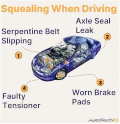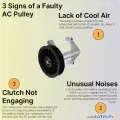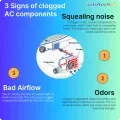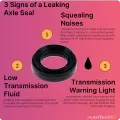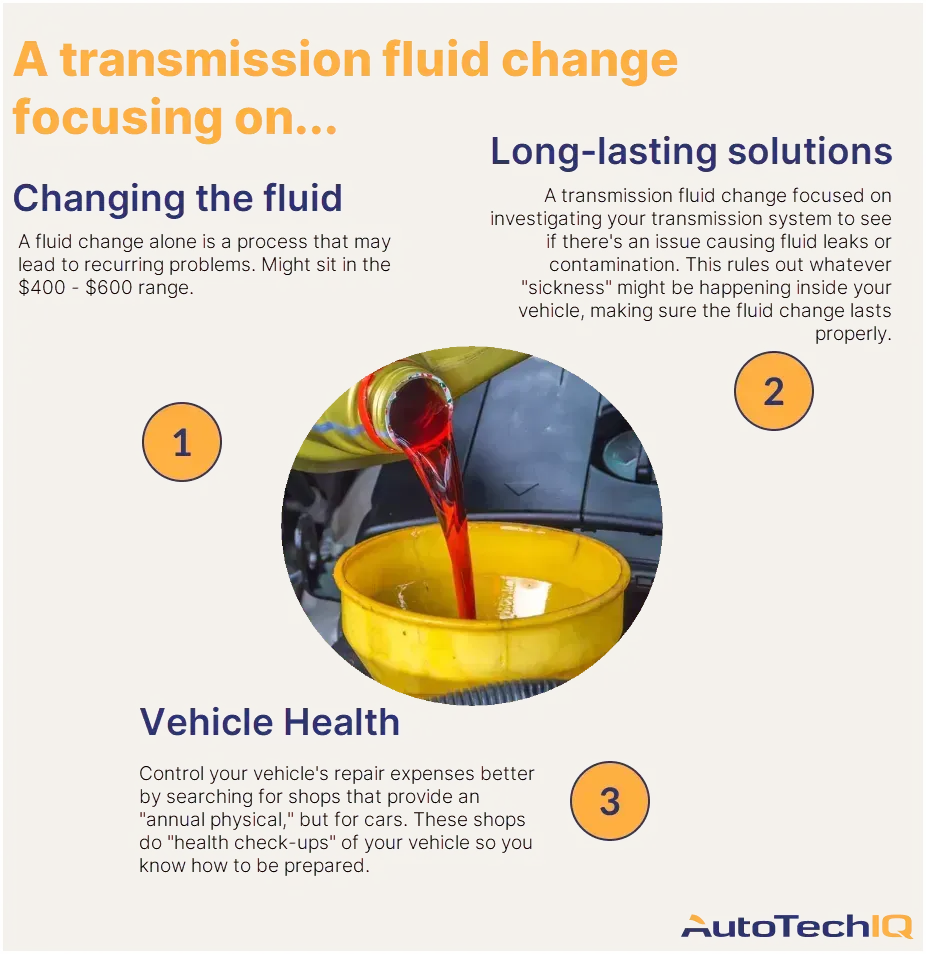
How much is a transmission fluid change?
A typical transmission fluid cost can range from $200 to $500.
Transmission fluid changes can vary in price between models. For example, the cost for a 2019 Chevrolet Tahoe might sit around $390 to $500, whereas a 2022 Audi Q3 could stay in the $350 to $400 range. A BMW 740i can range from $600 to $750.
Transmission Fluid
The transmission fluid is a residue that lubricates, cools, and cleans your transmission system. So, it’s a must-have to keep your vehicle in good shape for many miles. Additionally, the transmission fluid gets pushed through transmission lines, creating hydraulic pressure. This pressure is the strength that makes your gears shift easily.
Watch out: If your car starts running low on transmission fluid, there will be extra wear and tear on transmission components. So, to avoid internal damage and issues like slipping gears, overheating, rough shifting, clunky noises, exaggerated screams from the car’s transmission, etc., do your transmission fluid changes at the right intervals. Missing out on this maintenance care can cost you some big bucks in the future - and risk your safety on the road!
How much is a transmission fluid flush? Is there a difference?
A transmission fluid flush costs around $130 - $250, and yes, a transmission fluid change is different from a flush. A transmission fluid flush uses a machine to push all the transmission fluid out of your vehicle’s system and replace it with new fluid.
On the other hand, a transmission fluid change is more manual and focuses on lowering the transmission pan and draining it. In short, the flush is more “aggressive” and gets rid of all the old oil, while the change still replaces old fluid but doesn’t “remove” it as thoroughly.
Transmission fluid change cost: What affects the final price?
There are two ways a shop can quote you on a transmission fluid change. The first is if you only ask for a transmission fluid change. The second is if you ask for an investigation to find out if there’s a “hidden” problem in your car affecting the transmission fluid and a permanent fix for it.
Here are the common costs if you ask only for a transmission fluid change:
-
The labor rate: Labor rates change between professionals (ASE technicians charge more than rookie mechanics), and regional wage differences.
-
The shop’s neighborhood/area: Areas will determine the replacement cost. For example, Santa Barbara in California has different prices than Albuquerque, in New Mexico; this could be due to lease rates, cost of living, etc.
-
The vehicle type: European brands like Mercedes, BMW, Audi, etc., have different prices for transmission fluid change. Some models can require changing the transmission filter along with the fluid.
How does the transmission fluid return my vehicle to safety standards?
If your transmission fluid dropped in level or got contaminated due to common reasons, meaning it wasn’t leaking or getting dirty because of something else, then a fluid change returns the vehicle to safety standards.
But, you can’t be sure if the problem won’t return without at least a transmission inspection. The inspection gives mechanics the confirmation if only a transmission fluid change takes care of everything, or if a deeper process is best.
The inspection needs to focus on the transmission system because the fluid touches parts of it and runs through its lines.
What exactly is a transmission system inspection?
The transmission system inspection is a paid “detective work” where mechanics note and record everything that’s not working as expected in your transmission system.
-
Mechanics inspect the vehicle, noting everything about the transmission’s performance/safety and searching for any issue causing leaks or contamination to the transmission fluid.
-
They show you their observations and propose suggested repairs to get the transmission fluid in proper condition and level.
-
They do a quote for the suggested repairs.
The proposed repair after the inspection might be just a transmission fluid change if there were no leaks or contaminations in the system. But, if the main problem is not just normal transmission fluid time wear and involves other systems, the suggested quote will increase.
Here are the routes you can go based on your options.
-
Transmission fluid change: This means you want the transmission fluid change and nothing else, so you’ll probably only pay for common replacement costs. The downside is that you might not discover if anything caused the transmission fluid to go bad in the first place. Assume there’s a problem somewhere else in your car that’s contaminating or causing leaks in the transmission fluid. In this situation, a transmission fluid change won’t solve the issue, it might just make you return to the shop soon to change the fluid again.
-
Long-lasting fix: This means you want to permanently fix your vehicle and understand what might be wrong with it. So, you want to investigate if there’s an issue causing your transmission fluid to require a change, and if there is, you want to eliminate it. You’re willing to spend more money to cover extra processes that ensure your car runs safely and reliably.
Why have a long-lasting fix? The short answer is to save money and stress while ensuring the vehicle is safe for the next thousands of miles. A long-lasting fix provides maximum safety with the goal of not having you return to the shop for a really long time.
The long-lasting fix is a path that just means you want to have an investigation and get a complete solution IF there’s a deeper issue. So, for the transmission system, it doesn’t necessarily mean you’ll need to repair a bunch of transmission parts; it just means you’re willing to repair parts that are bad for transmission fluid, if there are any.
It boils down to it being better to be safe than sorry.
If there’s a bigger problem, how much will a long-lasting transmission fix cost?
A long-lasting transmission fix has factors changing the final price. Here’s what you can expect:
-
Transmission system inspection: A transmission system inspection to find out what’s affecting your transmission fluid usually costs below $200. This is an investigation of your transmission system involving the labor of service advisors and mechanics to discover issues/due repairs.
-
Component replacements: The inspection indicates any worn components in the transmission system that require replacement. This depends on the specific condition of the vehicle.
-
Other systems repairs: The shop might find other malfunctioning systems requiring parts replacements and/or computer reprogramming, affecting the cost range. For example, a bad transmission situation can force the engine to overwork, leading to overheating and further repairs. In worst cases, costs can go north of $2000.
How to get transparent long-lasting repairs
If you want to:
-
Investigate what’s happening to your transmission fluid: Discover if something is making it leak or contaminating it.
-
Fix the whole problem: If something is indeed causing leaks or contamination, fix that so it doesn’t return anytime soon.
-
Get maximum safety: Drive with peace of mind, knowing your transmission is 100% safe and you’re far from visiting the shop because of it again.
Then, relying on online estimates is MISLEADING. Online estimates only price the transmission fluid change based on different quotes, and won’t consider whether you want a long-lasting solution. The solution to your transmission fluid problems is specific to your vehicle.
How to spot shops that do long-lasting repairs? The best way to get a precise estimate is to seek shops with a certified “transparency process” to perform a transmission system inspection for you.
How do these transparent shops help you budget? Basically, you’ll pay for an inspection, and get a comprehensive list of things that you need to fix to keep your transmission fluid in proper condition. This list will have everything you need to worry about your transmission system, including future recommendations and immediate suggestions.
Fortunately, these come with edited images and videos of your car so you can understand and make an informed choice of what you’ll prioritize. Prices will be clarified, so you’ll know what you spend.
But, of course, there’ll be a suggested repair track made by the service advisor.
Let’s see an example of a transparency-focused transmission fluid change.
What does a transparent, long-lasting fix for transmission fluid issues look like?
A transmission system inspection is the best way to make sure your transmission fluid change is really all you need. You want to rule out if something is contaminating or leaking it. So, here’s what the inspection might look like.
In this case, a full transmission system inspection’s main goal is to discover the transmission fluid condition, investigate if it’s contaminated or leaking from somewhere, and check if all transmission components work as expected.
For instance, if a shop is requested to do a transmission system inspection due to the fluid requiring a change sooner than expected, the mechanics examine everything related to the system.
They’ll check every transmission component for signs of wear, tear, or leaks to find if something prevents the fluid from remaining at a healthy level and condition. The inspection may reveal the need to replace various components and identify anything affecting the transmission fluid.

For example, if mechanics find a faulty axle seal that’s allowing transmission fluid to escape, they’ll mark it as a leak point, photographing it to include in a later report. You’ll basically have the images, videos, and explanations from the expert in a file. Of course, you’ll be encouraged to shoot your questions to get any clarification.
In this case, the mechanic put the “Immediate Attention” tag on the axle seal and transmission fluid since ignoring them results in extra issues. This means the two main priorities are to fix the axle seal to avoid leaks and change the transmission fluid.
The final quote also suggests replacing naturally worn transmission components they’ve spotted during the inspection.
Why this level of transparency?
These businesses want to help you make the right decisions by providing education about your car so you can budget for the necessary repairs at current and future visits. It’s cost-beneficial for you and the auto repair facility.
Why is it cost-beneficial for you?
They won’t simply fix your problem. They’ll make sure it doesn’t return for thousands of miles.
Why is it cost-beneficial for them?
Most of these shops want to keep you as a customer for life. They want people to trust and recommend them, strengthening their bond with the community and growing their businesses.
The “find shops providing a DVI” method
Fortunately, you can have that level of transparency beyond the transmission system inspection. The so-called DVI method leads you to shops offering a transparent vehicle health check-up.
This method focuses on two things:
-
Does the shop have a modern DVI?
-
Does the shop have certifications?
What’s a DVI? As mentioned earlier, It’s like an annual physical visit to the doctor to assess the body’s vital signs, but for a car instead; most auto repair shops don’t charge to do it. The DVI regularly creates your vehicle’s “state of health,” explaining its overall condition.
The mechanic uses the DVI results to inform the conditions of your vehicle’s systems and the recommendations to get it running reliably. If they find issues, they’ll list them in order of priority.
Let’s see an example of how the DVI can help with a transmission fluid change:
A DVI helps with a transmission fluid change
The DVI starts with the mechanic checking vehicle systems (seals, bearings, connections, etc.) for signs of wear/tear/leaks. They’ll document everything through notes, videos, and pictures.
Here are some important things about a DVI:
-
It’s a visual inspection: The mechanic looks at the car’s component’s surface, searching for obvious problem signs.
-
It also checks for noises: The mechanic listens to your car sounds and points out unusual noises.
-
It does not include further testing: A DVI doesn’t mean in-depth tests and investigations, it’s a surface-level report that indicates if a car needs repairs or deeper inspections.
If they spot transmission issues, they’ll edit images and videos to indicate points of concern (damages, leaks, components’ locations, etc.) surrounding the transmission. They’ll highlight their findings using arrows, circles, and text.
In the image below, the mechanic found that the transmission fluid was leaking due to a faulty axle seal.

A document with the vehicle’s health status is sent to the customer, with room for questions through online/phone or over-the-counter communication. The customer sees what repair priorities their vehicle has and what should be checked in the near future.
In this case, they’ll see an axle seal replacement and transmission fluid change priority. The focus is to educate and help the customer make informed decisions about their car.
Certifications that help you
Today’s auto industry has certifications for customer-educational and transparent businesses. For example, the AutoTechIQ certification makes shops that fit into the DVI method stand out on your local map. So you can find the one closest to you.
The shops with an AutoTechIQ certification typically feature 100+ excellent Google reviews! You can quickly find this certification on a shop’s website or using AutoTechIQ’s “Find a shop” map.
Transmission Fluid Change FAQ
How long until I need to change my transmission fluid?
The interval for changing transmission fluid depends on the type of transmission, your driving conditions, and your vehicle manufacturer’s recommendations. For most automatic transmissions, the fluid should be changed every 30,000 to 60,000 miles, while some newer vehicles with advanced fluids can go up to 100,000 miles before needing a change. Manual transmissions often have different requirements, with recommended intervals ranging from 30,000 to 50,000 miles.
When changing transmission fluid, what else should be checked?
When changing transmission fluid, it’s important to inspect other components of the transmission system to ensure everything is functioning properly. Start by checking the transmission filter, if applicable, as it should be replaced to prevent debris from circulating in the system. Inspect the transmission pan for metal shavings or debris, which could signal internal wear, and replace the pan gasket if it shows signs of leaks or damage. Examine the seals, hoses, and connections for cracks or leaks, as these can lead to fluid loss and potential transmission problems. Additionally, check the transmission cooler and lines for blockages or damage, especially if your vehicle is used for towing or heavy-duty driving.
Can you drive a car with contaminated or old transmission fluid?
Driving a car with contaminated or old transmission fluid is possible but not advisable, as it can lead to significant damage to your transmission over time. Transmission fluid plays a critical role in lubricating moving parts, cooling the system, and ensuring smooth gear shifts. When the fluid becomes old, contaminated, or degraded, it loses its ability to perform these functions effectively. This can result in symptoms such as rough or delayed shifting, slipping gears, overheating, or strange noises from the transmission.
How much does a transmission fluid change cost?
The cost of a transmission fluid change usually falls between $80 and $250, depending on your car's make and model. Some shops charge more if your vehicle needs special fluid or a more tricky service.
How much is a transmission flush compared to a fluid change?
A transmission flush is more “aggressive” than a normal transmission fluid change, and it usually costs between $130 and $250. That’s because a flush pushes all the old fluid out, while a basic change only swaps it, leaving some bits behind.
What is the difference between a transmission fluid change and a transmission flush?
-
A transmission fluid change drains some of the old fluid and replaces it with new fluid. It’s a quicker, cheaper, and less invasive process.
-
A transmission flush completely removes all the old fluid, cleans out contaminants, and refills the system with fresh fluid. It’s more expensive but gives a deeper clean.
Why does the transmission fluid replacement cost vary so much?
The transmission fluid replacement cost varies because of:
-
Your car's make and model – Luxury and performance cars usually cost more.
-
Labor rates – Prices vary by location and shop.
-
Type of fluid needed – Some vehicles might ask for a specific kind of transmission fluid, like a Valvoline High Mileage Full Synthetic, which can be pricey.
Can I change my transmission fluid myself to save money?
Yes, but it’s messy and tricky. If you know your way around a car, a DIY transmission fluid change could cost around $40 to $100, but you need the right tools and kind of fluid (for example, an original CVT fluid, if your vehicle’s transmission is CVT). If you do it wrong, you might get a heftier bill to pay.
What happens if I don’t change my transmission fluid?
Skipping a transmission fluid change can lead to slipping gears, overheating, rough shifting, a transmission warning light, and total transmission failure. Fixing a damaged transmission costs way more than just keeping up with fluid changes.
